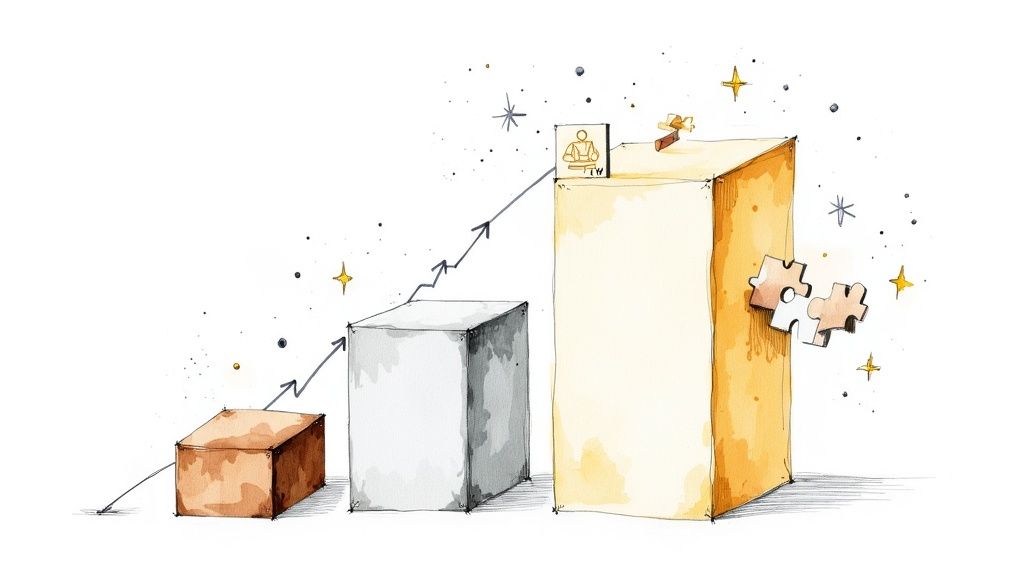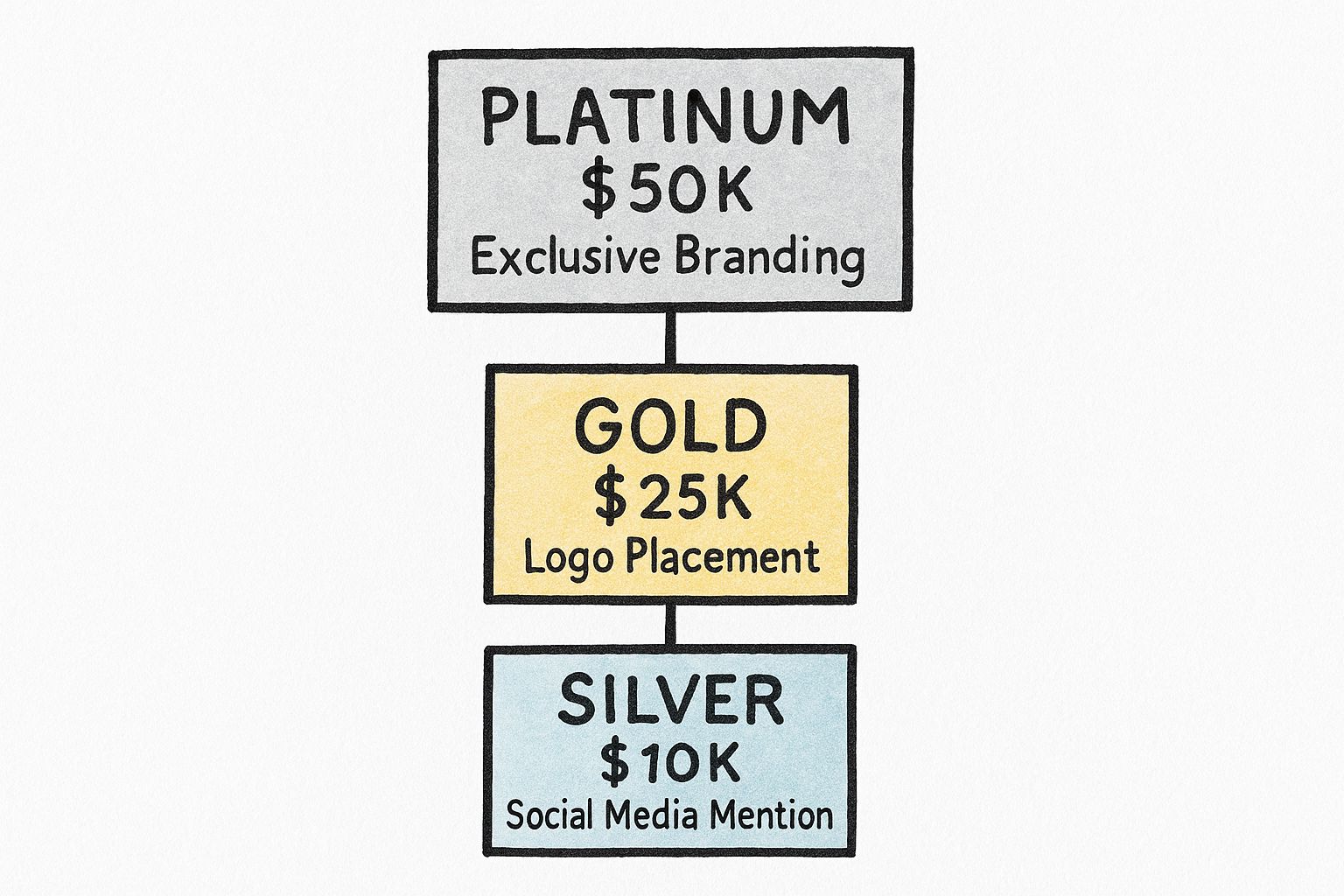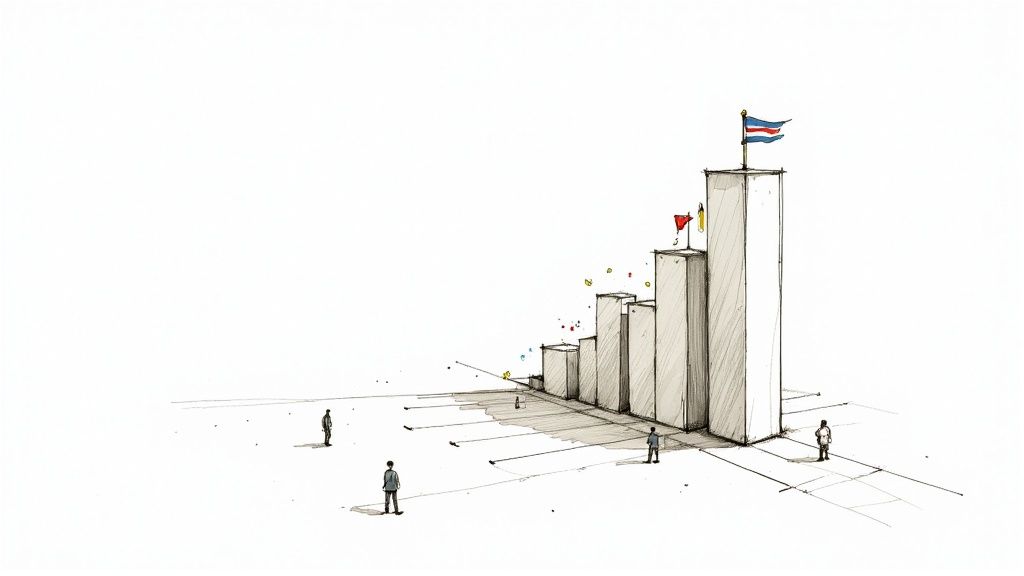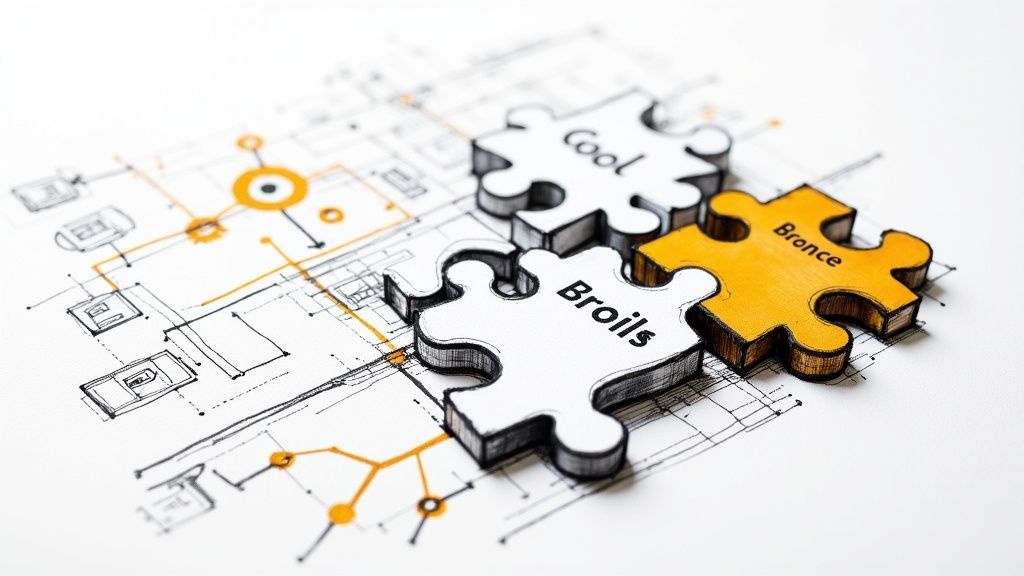July 26, 2025

At its heart, an event sponsorship package is a thoughtfully curated menu of benefits you offer to a company in exchange for their support, whether that’s cash or in-kind contributions. But don't think of them as simple ad placements. They are strategic partnership agreements that can provide the funding you need, boost your event's prestige, and significantly widen your reach.

Let's shift our perspective for a moment. Sponsorship packages aren't just a line item on a budget to cover costs—they're the very lifeblood of a memorable event. They represent a powerful business alliance where everyone wins. For you, the event organizer, they deliver the financial security needed to pull off a truly top-notch experience. For the sponsor, they open a direct line of communication to a highly engaged and relevant audience.
This give-and-take transforms a basic transaction into a genuine partnership. Your event becomes the stage, and the sponsor's brand gains instant credibility and visibility just by being associated with it. Learning how to build these packages isn't just a "nice-to-have" skill for an event organizer; it's absolutely essential.
The growing demand for meaningful sponsorship opportunities isn't just a fleeting trend; it's a market that's expanding at an incredible pace. This growth highlights just how much value brands place on connecting with people through experiences, both in-person and online.
Just look at the global sports sponsorship market, which often sets the pace for the wider events industry. It was valued at around USD 60.17 billion in 2024 and is expected to more than double by 2033, rocketing to a projected USD 132.86 billion. This surge is fueled by the massive appeal of global events in sports like football, basketball, and cricket. You can read more about this significant market growth to understand its broader implications.
A well-structured sponsorship package does more than just list benefits. It tells a story about how a partnership with your event will help a sponsor achieve their specific marketing goals, whether that's lead generation, brand awareness, or community engagement.
So, what goes into a sponsorship package that actually gets a "yes"? To build an offer that truly connects with potential partners, you have to understand the fundamental pieces that make it valuable and justify their investment. These components are the building blocks of a compelling proposal.
To give you a clearer picture, here’s a breakdown of the core elements that every strong sponsorship package should include.
This table breaks down the core elements of a typical sponsorship package, giving you a quick reference for building your own.
Each of these components adds another layer of value, turning a simple logo placement into a multifaceted marketing opportunity that a sponsor will find hard to resist.
You've seen it a thousand times: the classic Gold, Silver, and Bronze model for sponsorship packages. There's a good reason it's a staple in the event world—it just works. This tiered structure is more than a simple way to organize your offerings; it’s a psychological roadmap that helps guide sponsors to a decision that feels right for them. When you offer clear, distinct levels of value, the choice becomes intuitive.
Think of it like buying a car. The base model (your Bronze package) is solid and gets you from A to B with the essentials. The mid-range model (Silver) adds the features most people want, like a better sound system and heated seats. Then you have the fully-loaded, premium model (Gold or Platinum) with every bell and whistle—the one that really makes a statement. Your sponsorship tiers should create that same feeling, where upgrading feels like a smart, natural step up.
This image shows a typical hierarchy, illustrating how the price and benefits climb as you move up the ladder.

As you can see, the high-impact branding and exclusivity are reserved for that top tier, making it clear why it commands the highest investment.
The secret to a killer tiered model is making the difference between each level crystal clear. A potential sponsor needs to immediately understand why one package costs more than another. Vague promises like "increased visibility" won't cut it. You need to offer concrete, escalating benefits that tie directly to what they want to achieve.
Most event organizers find that a three or four-tier structure hits the sweet spot. Too few options can feel limiting, but too many can cause "analysis paralysis," where sponsors get overwhelmed and don't choose at all. Considering that 98% of consumers say they are more likely to engage with a brand after an event activation, each tier must give sponsors a real way to connect with your attendees.
Here’s what a logical progression across three tiers might look like:
Your job is to make each package so compelling that it practically sells itself. The value needs to be so apparent that a sponsor instantly sees the path to achieving their goals, whether that’s generating leads, establishing themselves as a thought leader, or simply getting their product into people's hands.
A simple rule of thumb: Create your tiers so the jump in value from one to the next is greater than the jump in price. When a sponsor sees they're getting significantly more for a relatively small price increase, upgrading becomes a no-brainer.
When you design your sponsorship packages with this strategic, value-first mindset, you aren't just selling ad space. You're building partnerships. You're guiding sponsors to the best fit for their goals, which lays the groundwork for a strong relationship and makes them eager to come back next year.

Truly great sponsorship packages are about more than just slapping a logo on a banner. They are a carefully curated menu of benefits designed to meet a sponsor's core marketing goals, making the decision to invest in your event a no-brainer. To build an offer they can't refuse, you need to think in two categories: the tangible and the intangible.
Tangible benefits are the things you can see and touch—the concrete assets a sponsor gets for their money. They're straightforward and easy to measure. On the flip side, intangible benefits are all about perception, association, and exclusive access. These are often the most powerful motivators that drive the biggest investments.
These are the foundational elements, the must-haves that provide direct visibility and real opportunities to connect with your audience. Think of these as the building blocks for your sponsorship tiers, with value increasing at each level.
While the tangibles are essential, the intangibles create that "wow" factor that justifies a premium price tag. These perks appeal to a sponsor's desire for prestige, influence, and connections that money can't always buy.
The most valuable partnerships are built on more than just visibility. They're built on the exclusive access and brand alignment that only your event can provide, transforming a sponsorship from an expense into a strategic investment.
Consider weaving in these high-value intangible perks:
The sponsorship world is always changing, and modern event sponsorship packages are starting to reflect deeper social values. With younger generations like Gen Z influencing the market, brands are increasingly looking for ways to show their commitment to Diversity, Equity, Inclusion, and Belonging (DEIB) and Environmental, Social, and Governance (ESG) goals.
Sponsorships are becoming a vehicle for social impact, and you can discover more about these global sponsorship trends to stay ahead of the game. By blending concrete assets with exclusive intangible benefits, you create a complete package that delivers undeniable value and a clear return on investment.
https://www.youtube.com/embed/YpcRcb0BM-0
Figuring out what to charge for sponsorship can feel like a high-wire act. Price too high, and you risk scaring off fantastic partners. Price too low, and you're leaving money on the table that could have made your event even better.
There’s no magic number that works for every event. Instead, the real secret is to stop guessing and start strategizing. The best approach is to blend three different pricing perspectives to land on a number that’s fair, profitable, and makes perfect sense to your sponsors.
First things first, you need to cover your expenses. This is the foundation of your pricing strategy, and it’s called cost-based pricing. Think of it as your financial safety net—it guarantees you won’t lose money on the event.
Start by adding up every single expense required to pull off your event. This includes the big-ticket items like venue rental, catering, and AV equipment, but also the smaller things like marketing costs, staff time, and speaker fees. From there, calculate the direct cost of delivering each sponsorship benefit. How much does it actually cost to print a logo on a banner or set up a branded charging station? This gives you a baseline price floor for each package. You know you can't go lower than this.
Covering costs is just the starting point. The real money—and the reason sponsors will pay a premium—comes from value-based pricing. This is where you shift your thinking from "what does this cost me?" to "what is this opportunity worth to the sponsor?"
This is all about putting a number on the incredible access and exposure you're offering. For example, how many eyeballs will see a sponsor's logo on your main stage? What's the going rate for a qualified lead in your industry, and how many can a sponsor expect to gather at your event? A keynote speaking slot that positions a brand as a thought leader is infinitely more valuable than a simple logo on a webpage.
Think of it this way: A sponsor isn't just buying ad space; they are buying direct access to a curated, engaged community. They're buying the trust and credibility that comes from being associated with your event. The price should reflect that massive opportunity.
To do this well, you need to know your numbers—audience demographics, past engagement metrics, and social media reach. The more clearly you can articulate this value, the more you can charge. Tying your packages into a broader set of event marketing strategies can also dramatically increase the perceived value for your partners.
Once you understand your costs and the value you're offering, it's time to package it all into clear, easy-to-understand tiers. Most events stick to a simple Gold, Silver, and Bronze structure, and for good reason—it works. It gives potential sponsors a clear "good, better, best" choice.
The key is to make the jump between tiers feel worthwhile. Each level should offer a significant step up in value, encouraging sponsors to aim higher. The Bronze package might offer basic brand visibility, while the Gold package provides exclusive access, speaking opportunities, and direct lead-generation tools. This structure makes the decision-making process much simpler for your sponsors.
Here’s a simple table to illustrate how benefits and pricing can scale across different tiers.
This table illustrates how to scale benefits and pricing across three tiers to create a clear and compelling value proposition for potential sponsors.
By laying out your packages this way, you create a clear ladder of value that helps sponsors justify a higher investment for significantly better returns.
Finally, it’s time for a reality check. With your costs covered and your value defined, you need to see how your prices stack up against the competition. This is called market-based pricing.
Do some digging. Find out what similar events in your city or industry are charging for sponsorships. Look at their tier structures, the specific benefits they offer, and what their top-tier sponsors get. This research isn't about copying them; it's about understanding the market you're operating in.
If your prices are much higher, you'd better be ready to explain why. Maybe your audience is more targeted, you offer more sophisticated lead-capture technology, or you provide more exclusive networking opportunities. This final step ensures your pricing is not only profitable and value-driven but also competitive and realistic.

You’ve put in the work and created some fantastic event sponsorship packages. That’s a great start, but those packages won’t sell themselves. The thing that gets you from a well-designed tier to a signed contract is your sponsorship proposal. This document is your most important sales tool, and making it work comes down to one simple idea: personalization.
Sending out a generic, copy-and-pasted proposal is the fastest way to get ignored. You have to think less like a salesperson and more like a consultant. Your goal isn't just to list a bunch of benefits; it's to prove you understand a potential sponsor's unique business challenges and that your event is the solution. Remember, a massive 98% of consumers say they are more likely to engage with a brand after an event activation—that's a powerful stat to have in your back pocket.
Before a proposal ever leaves your outbox, it needs to look and feel professional. It should be visually clean and easy to scan, because it’s a direct reflection of the quality of your event. A clunky, poorly designed document kills credibility before they've even read a word.
Make sure every proposal you send includes these core elements:
The most crucial part of this whole process is tailoring each and every proposal. Dig into the company you're pitching. Look at their recent marketing campaigns, figure out who their target customer is, and use that insight to frame the conversation.
A great sponsorship proposal doesn't just ask for money. It presents a partnership opportunity so aligned with the sponsor's goals that saying "yes" feels like the most logical business decision they can make.
For example, if you're pitching a tech company that just released a new app, you'd want to highlight benefits like a sponsored Wi-Fi network or a branded charging lounge. But if you’re approaching a brand focused on community building, you might emphasize a sponsored workshop or a dedicated networking space. This custom approach proves you view them as a genuine partner, not just a walking wallet.
If you want to see how this looks in practice, this sample sponsorship proposal is a great resource that shows how to structure a document for real impact. When you focus on solving their problems, you create a proposal that doesn't just get read—it gets signed.
That final handshake? It’s not the finish line. It’s the starting pistol for building a real, long-term partnership. If you want to turn a one-time sponsor into a recurring champion for your events, you absolutely must prove their investment paid off.
This is where a post-event fulfillment report comes in. Think of it less as a dry report and more as the highlight reel of your partnership. It’s your chance to tell a data-backed story, showing them exactly what their money bought them and why they should be excited to do it all over again.
A great fulfillment report isn't just a thank-you note with some numbers sprinkled in. It’s a polished, professional document that translates your event's energy into the language of a marketing team: results.
Here’s what you need to show them:
The whole point of a fulfillment report is to leave zero doubt in a sponsor's mind about the value they received. When you show them clear, measurable results, their investment stops feeling like an expense and starts looking like a major marketing win.
This kind of professional follow-through is more important than ever. Consider the sports sponsorship market, which is expected to explode from USD 62.40 billion in 2024 to USD 115.38 billion by 2032. As you can discover more about these market forecasts, brands are pouring money into events to find engaged audiences, making the competition for good partners fierce.
Ultimately, delivering a comprehensive ROI report is a non-negotiable part of mastering how to get a sponsor and, crucially, how to keep them. It proves you're a pro, cements your event’s value, and sets the stage for even bigger and better partnerships down the road.
Stepping into the world of event sponsorship can feel like navigating a maze. Even if you've been doing this for years, certain questions always seem to pop up. Let's tackle some of the most common ones so you can build your proposals and approach sponsors with complete confidence.
You'll see a lot of different setups, but the sweet spot for most events is three to four tiers. Think of the classic Gold, Silver, and Bronze structure—it’s popular for a reason. It gives potential sponsors clear, distinct options without overwhelming them.
If you offer fewer than three tiers, it can feel too limiting, almost like a "take it or leave it" proposition. On the other hand, go past four or five, and you risk "analysis paralysis," where a potential partner has so many choices they can't make a decision. The key is to make the jump in value between each tier obvious and compelling.
The tiered model is the one we're all familiar with. You bundle a set of benefits into predefined packages (Platinum, Gold, etc.), and a sponsor picks the one that aligns with their budget and marketing goals. It’s straightforward, easy to explain, and efficient to sell.
An à la carte model is more like a custom menu. It lets sponsors hand-pick individual sponsorship items to create their own package. This is perfect for sponsors who have a very specific goal in mind, like wanting to be the sole sponsor of the event's Wi-Fi network or the official host of the opening night cocktail hour.
The most successful event organizers I know often use a hybrid approach. They'll present their standard tiers as the main offering but stay flexible enough to build a custom package for a major partner with a unique idea. It gives you the structure of a tiered system with the flexibility of à la carte.
The short answer? Yesterday. For the best results, start your outreach six to twelve months before your event date. This isn't just about being organized; it’s about aligning with how your target sponsors operate.
Large corporations, the ones with the biggest budgets, plan their marketing spend and event participation way in advance. Getting in front of them early respects their budget cycles and shows you’re a professional. It also naturally creates a bit of urgency—the best spots are limited and will go to those who act first.
Ready to manage your sponsorships, memberships, and events all in one place? GroupOS provides the tools you need to create compelling ticketing experiences, showcase sponsor value with dedicated profiles, and track engagement with powerful analytics. Streamline your entire process and focus on growth. Start your free trial with GroupOS today.


